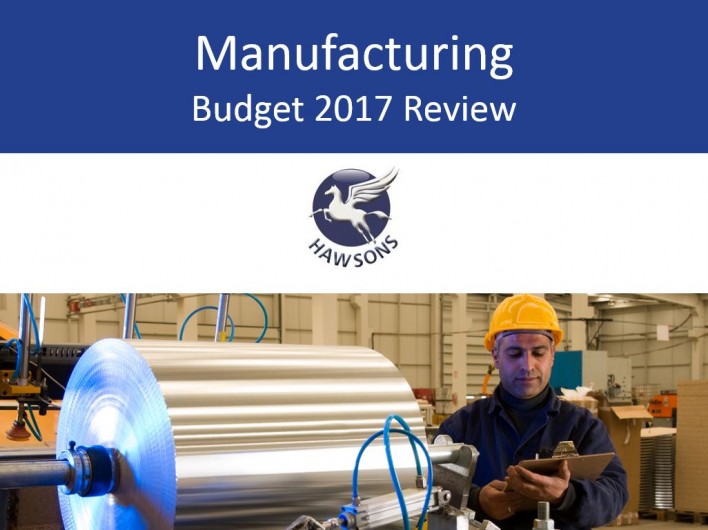The Chancellor Philip Hammond presented the last Spring Budget on Wednesday 8 March 2017. In his speech the Chancellor was keen to point out that he wanted the tax system to be fair, particularly in relation to the distinction between employed and self-employed individuals. In this article, we look at how the Chancellor’s Spring Budget impacts the manufacturing sector.
In the Budget speech the Chancellor announced that he has requested a report to be delivered in the summer on the wider implications of different employment practices. Also, the Budget included changes to NICs and the Dividend Allowance.
In December and January the government issued a number of clauses, in draft, of Finance Bill 2017 together with updates on consultations.
The Budget updates some of these previous announcements and also proposes further measures. Some of these changes apply from April 2017 and some take effect at a later date.
Our summary focuses on the issues likely to affect you and your business.
Main Budget tax proposals
Our summary concentrates on the tax measures which include:
- increases to the Class 4 National Insurance rates – Update 15/03/17 – Chancellor withdraws plans to increase NI.
- a reduction in the Dividend Allowance
- changes to the timing of Making Tax Digital for smaller businesses.
Previously announced measures include:
- increases to the personal allowance and basic rate band (a decreased band for Scottish residents)
- the introduction of the Apprenticeship Levy
- changes to corporation tax loss relief
- the introduction of an additional inheritance tax residence nil rate band
- changes for non-UK domiciled individuals.
Main Budget announcements (manufacturing specific)
- Originally raised NIC rates – but this was later withdrawn by the Chancellor
- Those under the VAT threshold have an extra year (until 2019) to prepare for Making Tax Digital (MTD)
- Introduction of T-Level technical education routes
- Talent Funding programme to fund additional PhD places
- Simpler administration for R&D tax credits
- Dividend allowance will be reduced from £5,000 to £2,000 from April 2018
Manufacturing 2017 Budget impact
Little to report amid economic uncertainty
Although there is little to report, no news could be good news for the sector, in a period of economic uncertainty. There are a few details that do affect the manufacturing sector though, such as the delay to the Making Tax Digital project (MTD). The main reason many businesses are anxious for the introduction of MTD is because of the quarterly reporting system – requiring businesses to file, effectively, five tax returns. HMRC haven’t released much detail about this project so there is still a lot of uncertainty surrounding MTD, along with the extra burden of filing even more tax returns. However, the delay of an extra year (for those under the VAT threshold) is welcome news as we prepare for what is undoubtedly a huge change to the way we conduct tax returns.
Introduction of T-Level technical education routes
The Chancellor announced in his first and last Spring Budget a new T-level system. This is intended to put technical education courses on an equal footing with academic courses. This new system will increase the number of hours students train by 50% and replace the current 13,000 qualifications with 15. In order to pay for the new system, the Chancellor announced an extra £500m a year and the changes are expected to come into effect from 2019.
This is certainly welcome news to the sector, and Chris Hill, Manufacturing Specialist at Hawsons, commented: “The introduction of the T-levels is good news for the sector, especially at a time when there is a skill shortage threatening to put growth at risk and the economic uncertainty that currently surrounds Britain. Although it won’t solve the issues that currently face the sector, it’s certainly a start.” Coupled with the T-levels is the Talent Funding programme, aimed to fund additional PhD places and many of these places will be within STEM disciplines.
R&D Tax Review
There are two types of tax reliefs for eligible R&D expenditure. Under one of these, qualifying companies can claim a taxable credit of 11% in relation to eligible R&D expenditure. This is known as the Research and Development Expenditure Credit (RDEC). To further support investment, the government will make administrative changes to the RDEC to increase the certainty and simplicity around claims and will take action to improve awareness of R&D tax credits among small and medium-sized enterprises.
Dividends
The Dividend Allowance will be reduced from £5,000 to £2,000 from April 2018. The aim of this is to decrease to the tax difference between the self-employed and those working through a company. The government expect that even with the reduction in the Dividend Allowance to £2,000, 80% of ‘general investors’ will pay no tax on their dividend income. However, the reduction in the allowance will affect family company shareholders who take dividends in excess of the £2,000 limit. The cost of the restriction in the allowance for basic rate taxpayers will be £225 increasing to £975 for higher rate taxpayers and £1,143 for additional rate taxpayers.
More from our manufacturing experts
You can find all of our latest manufacturing sector news and newsletters here.
If you are looking for advice in a particular area, please get in touch with your usual Hawsons contact.
Alternatively, we offer all new clients a free initial meeting to have a discussion about their own personal circumstances – find out more or book your free initial meeting here. We have offices in Sheffield, Doncaster and Northampton.
Free initial meeting
Craig Burton
Partner, Sheffield


